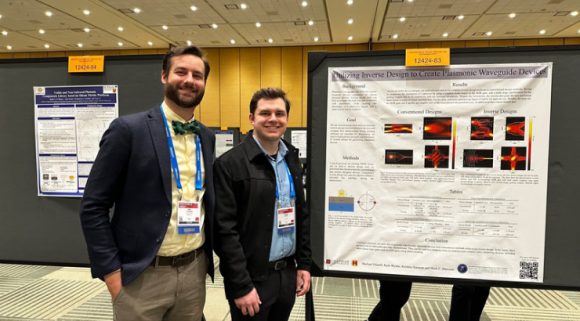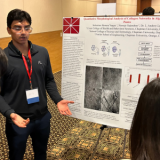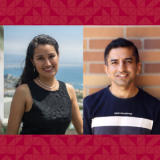
Optimizing Technology through Innovative Design: Fowler Engineering Faculty and Alumnus Publish Research on Inverse Design Strategies
December 6, 2023
At the Fowler School of Engineering (FSE), research opportunities are abundant for not just continuing faculty, but also for students overall. Coming from various engineering disciplines, such as computer science and software engineering, students have explored creative and innovative solutions to real-world modern problems.
FSE students explore the fullest potential of their research by presenting at Chapman’s research conferences, such as the Scholar Symposium hosted by the Center for Undergraduate Excellence (CUE) and the Summer Research Showcase through the Summer Undergraduate Research Fellowship (SURF). Elsewhere, Fowler student research has been displayed at the Southern California Conferences for Undergraduate Research.
Recently, Fowler Engineering alumnus Michael Efseaff (Computer Science ‘23) and professor Mark Harrison, Ph.D., published their research, “Strategies for optimizing plasmonic grating couplers with topology-based inverse design.” Their research, extended from Efseaff’s SURF project with Kyle Wynne (Software Engineering ‘24), focused on photonics, the physical science of light, and its relation to plasmonics and design.
Efseaff and Harrison’s research was selected for publication by the Society of Photo-Optical Instrumentation Engineers (SPIE). Eventually, their research was presented at Photonics West, SPIE’s research conference centered around photonics.
Setting Foundations for Intensive Research

Michael Efseaff ‘23 and Professor Mark Harrison presenting their research at SPIE’s Photonics West 2023.
Prior to SURF, Efseaff worked with plasmonic devices, the building blocks of computers. After being accepted into SURF, the Fowler alumnus continued to work with his interest and explored the depth offered by plasmonics. “My portion that I sort of fit my niche into was the topology optimization portion, using simulation software to build the devices,” he said.
For his most recent paper with Harrison, Efseaff experimented with strategies that optimized designs created by algorithm software.
“We used the optimization method to basically allow the most light through the device as possible and concur on the expected behavior because that basically means the more light you have going through it the better because there’s less light loss,” he said.
Using grating couplers, Efseaff physically produced devices and tested them in the lab. Being one of his favorite parts of research, Efseaff also noted that those very real creations were produced in an effort to diversify computer engineering.
“The end goal of those is that everything in your computer right now is made of and-gates, logic gates that you might learn in the intro to computer engineering courses, and basically, we’re trying to recreate that but with light instead of electricity,” he said.
The Challenges and Solutions of Specific Engineering Research
One particular challenge that Efseaff encountered was the vague reputation garnered by the field of photonics. Being a niche field, little is known about the potential behind this field of research.
“The field itself, you don’t learn about it in school,” he said. “There are not a lot of resources online that explain how it works. It was a huge learning curve in terms of just starting,” explained Eseaff.
Luckily, Harrison aided Efseaff by explaining complex photonic and plasmonic concepts through visual aids and real-world applications. Additionally, Dr. Harrison encouraged and trusted Efseaff to handle the research independently at times.
“[The research] also encompasses a lot of computer science, so it’s also a very multidisciplinary research because you’re doing optimization and coding but you’re also working with physics and beyond. A lot of these simulations take days, maybe even weeks, so make sure you’re not wasting your time,” Efseaff warned.
Harrison found a good balance in guiding and providing feedback on students’ writing and research, allowing them to remain in full creative control while also staying true to traditional academia guidelines and solving problems on their own. “I want to give my students the opportunity to learn how to work through problems independently, but as a researcher, I also want to make sure projects can be published in a timely manner,” he said.
The Future of Plasmonics and Topology-Based Design
After getting published for his research, Efseaff hopes that his paper will aid those interested in learning more about plasmonics and its potential benefits. The device simulations presented in his research paper offer a variety of both potential and tangible real-world applications.
“That sort of the end goal was to have this collection of individual devices that work and are optimized for our purposes and then eventually manufacture them together to create a logic circuit,” he said.
Advice for Potential Researchers
Given the considerable amount of time and dedication geared towards engineering research, students can expect similar challenges experienced by Efseaff, such as time constraints, periodic errors, and intensive writing. However, Efseaff offered some advice on how to get started and how to stay motivated throughout the research process.
“Don’t be scared of what you might not have experience in. I never heard of the word plasmonics before my interview with Harrison but ended up being super interesting and it indirectly in so many different areas. So, if you’re a computer science major and you don’t know, say, what biochemistry is, don’t be scared of that,” he said.
Efseaff also stressed the importance and benefit of starting early on in terms of experimenting with your research interests. “Even if they don’t have experience beforehand, do a little bit of background [research] on some areas that you can help within a reasonable amount of time. Try to find a digestible section of the work to do and be motivated to be independent,” he said.
Now, Efseaff applies his research expertise towards his current technology consultant position with EY. “At my current job, I work with generative AI and we’re kind of in the same space where a lot of the stuff we’re doing hasn’t been done before. So, it’s very familiar to me because of the research,” he said.
From Dr. Harrison’s perspective, it is important for students to be proactive and build relationships with faculty members, especially those who have the potential to become mentors. “If you are interested in research at all, reach out to faculty and ask them about research opportunities. You can find information about what faculty are working on online, and many of us are usually eager to work with students,” he said.
Read more about Efseaff’s and Harrison’s paper here. For more information on getting involved in research, visit our Engineering Research Opportunities website. Chapman’s SURF Applications open on January 30, 2024. For more details, visit the CUE’s official website.

